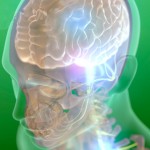 An optical technology for discriminating brain tumors from normal brain may eventually help surgeons in the operating room. Also this week: keeping neuronal growth on the straight and narrow.
An optical technology for discriminating brain tumors from normal brain may eventually help surgeons in the operating room. Also this week: keeping neuronal growth on the straight and narrow.
New Light on Brain Tumors
When patients with brain tumors undergo surgery, it’s hard for surgeons to tell where tumor ends and normal brain starts, which often means cancerous tissue is left behind. But generous margins may compromise brain function.
Now, a technique known as stimulated Raman scattering microscopy has shown better discrimination in preclinical studies, said investigators led by Sunney Xie, PhD, of Harvard University, who hope to develop the technology into a handheld probe to be used in the operating room.
Tumor tissue is relatively high in protein but low in lipids, while normal brain tissue is rich in both, the investigators noted in Science Translational Medicine. The Raman signal, generated by a laser and color-coded for tumor and normal tissue, allows doctors to tell which tissue is which — in real time during surgery.
In a blinded experiment, pathologists compared Raman images of mouse brain tissue with various stages of glioma with the same tissue stained with hematoxylin and eosin. They were able to make the correct diagnosis in all cases with the staining and in 99.5% of cases with the Raman images.
In mice with a human glioblastoma, the Raman method allowed researchers to distinguish tumor-infiltrated tissue from normal tissue, even in regions where both appeared normal under the usual bright light conditions. Hematoxylin and eosin staining later confirmed the differences.
The researchers noted that the method still needs some engineering development to make it usable in a normal operating room. A clinical trial is in planning stages.
— Michael Smith
Keeping Neurons on the Straight and Narrow
New insights into nervous system development and the body’s built-in quality control systems to forestall abnormal growth may lead to new treatments for neurodegenerative diseases, researchers at the University of California San Diego suggested.
Led by Yishi Jin, PhD, they reported identifying a two-component system in the laboratory roundworm C. elegans, involving a protein called EBAX-1 that functions as a detector of misfolded proteins in larval neurons and a heat shock protein that helps remove or repair the incorrectly developing neuronal proteins.
They also determined that this process helped protect against environmental stress such as hyperthermia, which can further impede the rapid and complex development process, with upregulation occurring when larvae were exposed to temperatures of 25 degrees C instead of the normal 20 degrees.
Because EBAX-1 is a highly conserved protein also found in humans, these findings may ultimately be helpful in developing therapies for diseases such as Alzheimer’s and Parkinson’s that are characterized by neuronal degradation, the researchers reported in Neuron.
— Nancy Walsh
Turned Off Gene Switches On Inflammation
Smooth muscle cells (SMCs) rush to the site of vascular injury and begin a cascade of pro-inflammatory responses that can lead to atherosclerosis — but the nature of the underlying biology responsible for SMCs pro-inflammatory reaction wasn’t known until now.
It appears that Kruppel-like factor (KLF) 15 — one of several of the KLF gene family members known to regulate blood vessel biology — was reduced by about seven-fold in human vessel samples that had been subjected to injury, according to Yuan Lu, MD, of Case Western Reserve University in Cleveland, and colleagues.
In addition, researchers found that KLF-15-deficient mice fed a high-fat diet had more and larger vascular lesions than controls and that KLF-15 blocked the function of a molecule called NF-kB, a dominant factor responsible for triggering inflammation — thereby finding a potential mechanism to explain KLF-15’s fundamental role in maintaining an inflammation-free state, they wrote in the Journal of Clinical Investigation.
These findings reveal more of the origins of inflammation in vascular diseases and may eventually lead to new, targeted treatment options, researchers wrote.
— Chris Kaiser
Growth Factor May Regulate Telomeres
Cortisol has garnered more attention as the hormone that could play a role in regulating telomere length, but insulin-like growth factor-1 (IGF-1) may have more of an influence, research suggests.
In a literature review, several studies showed that both IGF-1 and telomere length diminish with age, and both were positively and strongly correlated with each other, Anna Aulinas, MD, of Hospital de Sant Pau in Barcelona, and colleagues reported in Clinical Endocrinology.
“IGF-1 could be a tangible candidate involved in telomerase activation in cell growth and proliferation,” they wrote.
It’s not clear if the relationship is just an association, or if it has a cause-effect relationship, the researchers noted. But it is known that hormones play a role in regulating the function of telomerase, the enzyme charged with keeping telomeres long by preventing degradation after mitosis.